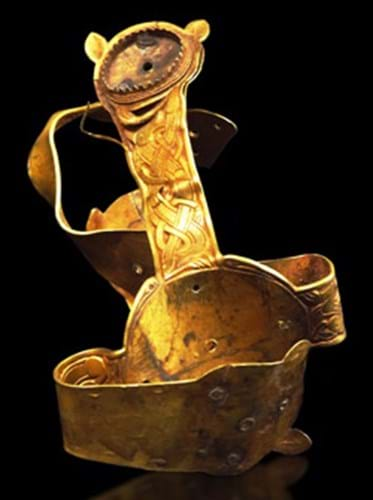
The cache of over 1500 Anglo-Saxon gold and silver objects was found in South Staffordshire by metal detectorist Terry Herbert in July and was excavated from its site by archaeologists from Staffordshire County Council and Birmingham.
The five kilograms of gold - with a melt value of around £100,000 - have been called priceless but their monetary valuation as art objects is important.
On September 24, the South Staffordshire Coroner formally declared the hoard "treasure". As laid out in the Treasure Act of 1996, ownership has passed to the crown, but the finder and owner of the land on which it was discovered are entitled to a reward of the treasure's full commercial value.
Unlike the admirable speed with which the excavation has been conducted, and placed in the public domain, coming up with that figure could take much longer. A special committee will now consult a panel of specialists that will include the antiquities trade and auction houses.
Cataloguing the hoard is not expected to be particularly difficult.
The obvious precedent for academic comparison is the Sutton Hoo burial, discovered in the shadow of the Second World War more than half a century before the Treasure Act, which contains much high status metalwork of similar gold and garnet construction.
But, given that Anglo-Saxon gold objects do not come on the market that often, there is far less to provide a commercial precedent.
The valuation committee may well refer to the £20,000 sale of a late 6th or early 7th century gilt pommel cap from a sword with a complex interlaced pattern (at Bonhams in April 2006) or the £125,000 paid by the British Museum for a set of Anglo-Saxon sword hilt fittings that were found by a metal detectorist in Market Rasen, Lincolnshire in 2002.
Adding further complications to the valuation are issues of context and historical importance.
Most Anglo-Saxon finds have come from East Anglia or Kent, but the Staffordshire Hoard was found further north in what was the Anglo-Saxon kingdom of Mercia. As such it will likely change perceptions and re-draw the map of Anglo-Saxon England.
Sutton Hoo is thought to be some kind of burial or cenotaph. The Staffordshire hoard consists largely of martial objects: sword fittings, shield bosses and strips from helmets and has more of the feel of a hoard of booty or plunder.
As ATG's coins and medals correspondent Richard Falkiner, who has served as a member of the valuations panel for Anglo-Saxon finds in the past, points out: "It is also too early to assess whether the burial of the hoard took place soon after the material was made or at a much later date."
While it will probably take years to assess the full academic significance of this find, three local institutions have expressed an interest in finding a home for the hoard: The Birmingham City Museum and Art Gallery, where the finds were unveiled (and will be on display until October 13); the Potteries Museum in Stoke on Trent; and Staffordshire County Council.
By Anne Crane




